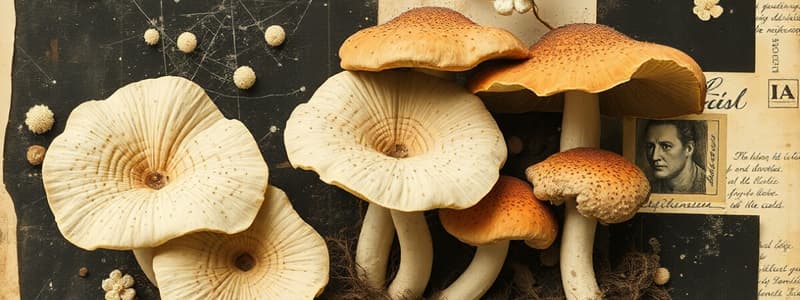Podcast
Questions and Answers
What is the primary purpose of using a GasPak system during bacterial inoculation?
What is the primary purpose of using a GasPak system during bacterial inoculation?
- To enhance colorimetric detection during testing
- To sterilize the inoculating tools
- To increase oxygen levels for anaerobic bacteria
- To create an anaerobic environment for growth (correct)
Which of the following accurately describes biological vectors?
Which of the following accurately describes biological vectors?
- Insects that mechanically carry microbes on their body
- Microorganisms that thrive in food and water sources
- Organisms that harbor pathogens within their body and transmit them via bites (correct)
- Pathogens that can be transmitted through food or water
What is the function of the secondary antibody in an ELISA test?
What is the function of the secondary antibody in an ELISA test?
- To capture the viral antigens in the well
- To produce colormetric detection through enzymatic reaction (correct)
- To detect color change indicating a positive reaction
- To wash away non-bound reagents
What behavior of tetrazolium indicates a positive bacterial growth result?
What behavior of tetrazolium indicates a positive bacterial growth result?
Why is it important to perform washing steps in an ELISA test?
Why is it important to perform washing steps in an ELISA test?
What is the intended use of a turbidimeter in bacterial identification?
What is the intended use of a turbidimeter in bacterial identification?
Which step is NOT part of the ELISA testing process?
Which step is NOT part of the ELISA testing process?
What is meant by 'negative control group' in an ELISA test?
What is meant by 'negative control group' in an ELISA test?
Which statement accurately describes facultative pathogens?
Which statement accurately describes facultative pathogens?
How long should a sample be incubated at 37 degrees Celsius during the ELISA process?
How long should a sample be incubated at 37 degrees Celsius during the ELISA process?
Which of the following statements about fungi is incorrect?
Which of the following statements about fungi is incorrect?
What is the primary difference between zygospores and conidiospores?
What is the primary difference between zygospores and conidiospores?
Which characteristic is true for opportunistic fungal infections?
Which characteristic is true for opportunistic fungal infections?
What is the purpose of using a blood agar plate in throat cultures?
What is the purpose of using a blood agar plate in throat cultures?
What is a characteristic feature of obligate anaerobes?
What is a characteristic feature of obligate anaerobes?
In urine cultures, what is significant bacteriuria?
In urine cultures, what is significant bacteriuria?
How do mold species such as Rhizopus stolonifer reproduce sexually?
How do mold species such as Rhizopus stolonifer reproduce sexually?
What role does the GasPak System play in cultivating anaerobic pathogens?
What role does the GasPak System play in cultivating anaerobic pathogens?
What is the temperature at which yeast typically grows best?
What is the temperature at which yeast typically grows best?
Flashcards
Fungi heterotrophs
Fungi heterotrophs
Fungi get their food from other organisms (organic matter).
Saprotrophic Fungi
Saprotrophic Fungi
Fungi that decompose dead organic matter.
Fungal Cell Wall
Fungal Cell Wall
Made of chitin, not cellulose like plants.
Hyphae
Hyphae
Signup and view all the flashcards
Mycelium
Mycelium
Signup and view all the flashcards
A-hemolysis
A-hemolysis
Signup and view all the flashcards
B-hemolysis
B-hemolysis
Signup and view all the flashcards
Urine Culture
Urine Culture
Signup and view all the flashcards
Significant Bacteriuria
Significant Bacteriuria
Signup and view all the flashcards
GasPak System
GasPak System
Signup and view all the flashcards
Facultative Pathogen
Facultative Pathogen
Signup and view all the flashcards
Vector
Vector
Signup and view all the flashcards
Mechanical Vector
Mechanical Vector
Signup and view all the flashcards
Biological Vector
Biological Vector
Signup and view all the flashcards
ELISA Test
ELISA Test
Signup and view all the flashcards
Antigen
Antigen
Signup and view all the flashcards
Antibody
Antibody
Signup and view all the flashcards
Biolog System
Biolog System
Signup and view all the flashcards
Turbidimeter
Turbidimeter
Signup and view all the flashcards
Positive Control (ELISA)
Positive Control (ELISA)
Signup and view all the flashcards
Study Notes
Fungi
- Fungi are heterotrophs, meaning they require organic carbon for survival.
- They are saprotrophs, decomposing dead organic matter.
- They can form symbiotic relationships with other species, such as algae or bacteria.
- Fungi are a food source and important for food production for humans and other organisms.
- Their cell walls are composed of chitin.
- They can be multicellular (molds) or unicellular (yeast).
- Fungi have hyphae, long, branching cellular structures.
- Hyphae can form an interwoven mass called mycelium.
- Vegetative hyphae grow along the substrate.
- Reproductive hyphae extend upwards to produce spores.
- Fungi exhibit thermal dimorphism, meaning mold growth occurs at room temperature, while yeast forms at 37 degrees Celsius.
- Some fungi are opportunistic pathogens, exploiting weak or immunocompromised individuals.
Types of Fungi
- Zygomycetes: Form zygospores during sexual reproduction and sporangiospores during asexual reproduction. A common example is Rhizopus stolonifer.
- Ascomycetes: Form ascospores during sexual reproduction and conidiospores during asexual reproduction. Penicillium notatum and Aspergillus niger are examples.
- Basidiomycetes: Form basidiospores during sexual reproduction. They typically lack well-defined asexual reproduction.
Lab 11: Infectious Disease
Throat Cultures
- Bacteria, like certain Streptococcus species, obtain iron from blood.
- Blood agar plates, containing 5% sheep's blood, are used.
- Alpha-hemolysis (partial breakdown of red blood cells): Greenish color.
- Beta-hemolysis (complete breakdown of red blood cells): Clear zones.
- Gamma-hemolysis (no breakdown): No color change.
Urine Cultures
- Diagnose Urinary Tract Infections (UTIs), most commonly caused by E. coli.
- Uses Eosin Methylene Blue (EMB) and Blood agar (BA) plates.
- Collecting a clean-catch urine sample is crucial.
- Urine is sterile in the body. Contamination occurs upon leaving the body.
- Significant bacteriuria occurs at a count of 100,000/mL of a single organism type.
- UTIs arise due to the presence of bacteria from the intestinal tract, with the anus being proximal to the urethra.
- Samples must be tested or refrigerated promptly to prevent bacterial growth.
Anaerobic Pathogens
- Anaerobic pathogens do not require oxygen to grow.
- Require GasPak System for anaerobic growth.
Vectors
- Vectors are disease-causing organisms transmitted through various pathways.
- Examples include food, water, respiratory droplets, and sexual contact.
- Vectors can be biological (carrying microbes internally, e.g., malaria mosquitos) or mechanical (carrying microbes on their bodies, e.g., flies).
Lab 12: Immunology
ELISA Test
- Used to detect antigens and antibodies.
- Used in diagnoses like HIV, EBV, pregnancy tests, drug screening, and food allergies.
- Uses a colorimetric method with a secondary antibody to indicate the presence of the targeted antigen or antibody.
- Procedures include adding antigens, incubating, washing, adding test reagents, incubating and checking for colorimetric reaction.
Biolog System
- Identifies bacteria based on metabolic properties.
- Uses a 96-well microplate to test carbon sources (sugars, amino acids) and sensitivity to various conditions (antibiotics, salinity).
- Positive metabolic tests exhibit purple color reactions due to reduced tetrazolium dye.
- Procedures include swabbing bacteria, preparing cell suspension, using a turbidimeter, adding suspension to wells, incubating, and reading results.
Studying That Suits You
Use AI to generate personalized quizzes and flashcards to suit your learning preferences.



